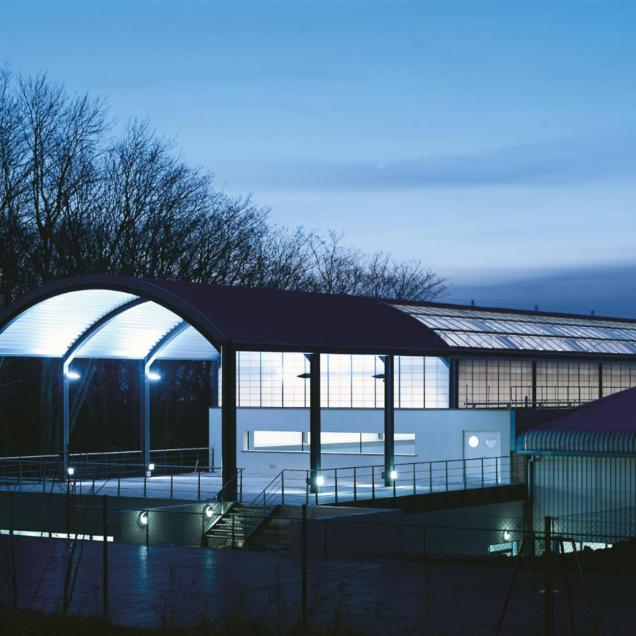

The real thing
Real tennis courts are traditionally in picturesque locations such as Hampton Court or Hatfield House. But, despite the more mundane setting, Middlesex University’s new court, by Pringle Richards Sharratt, easily matches the elegance of its predecessors.
Pringle Richards Sharratt’s Real Tennis court in Hendon, which opened last month, is only the fifth to be built this century, and brings the number of courts in the UK to 26 (there are just 41 world-wide). The £1.2 million building was financed entirely by a local enthusiast in the hope that a modern court accessible to young people would help re-popularise the game.
At the height of its popularity in France there were more courts than churches, around 320. Today jeu de paume, as the game is called in French (the Paris art gallery of that name was once a real tennis court), is seen as an obscure elite game with a small but loyal
following. Its origins are, in fact, humble. Thought to have started as a street game, it was once a gamblers’ sport, as popular and about as respectable as greyhound racing.
The building is an addition to Middlesex University’s Burroughs Health club, an ugly six-year old, crinkley tin shed which houses facilities such as a gym and aerobics studios. The pedigree of the Burroughs is no match for the grand settings of existing real tennis courts at splendid locations like Hampton Court, Hardwick House and Hatfield House. But real tennis players are a dedicated lot who want the game to be taken seriously as a sport, rather than it being seen as a quaint form of amusement for royalty.
It will be PRS’s first completed building since John Pringle and Ian Sharratt left Michael Hopkins & Partners and set up practice with Penny Richards in 1996. For Sharratt, the project director, the building has personal importance – he designed a real tennis court for his final project at the Royal College of Art.
The building consists of two main spaces – the full-height tennis court and, at the west end, a social space, with a café/bar and a workshop-cum-office for the coaches. In addition, along the north side, there are showers below a viewing gallery and outdoor terrace, from where the court can also be viewed through a slot window.
The architecture of real tennis courts has always been a key component of the game. Like a golf course, part of the interest in the game is in getting acquainted with the unique characteristics of a court. The ‘penthouse’ (the sloped wall which looks like a pitched roof and here is emphasised with unpainted hardwood panelling) would once have been a building in a street or market square. Apart from certain features, such as the overall dimensions and height and positioning of the net, every court is different, varying in the quality of its surface, the lighting and the precise configuration and angle of certain walls.
Although real tennis is usually played under cover, daylight is an essential requirement, and the lighting strategy, developed with Battle McCarthy using an artificial sky, was critical to the development of the scheme. PRS has tried to emulate the UK’s only open-topped court at Falkland Palace in Scotland (1539), allowing maximum daylight to enter through the vaulted roof and side walls, without creating shadows. The roof of a tennis court is traditionally pitched, but would have made the building too high so, since the planners were keen to minimise its height, the architect opted for a barrel vault supported by tied arches.
Three strips of windows in the roof let in north light, and when required the contrast between the sky and the underside of the roof can be reduced by horizontal translucent blinds supported on the trusses which act as a light shelf reflecting rays up on to the soffit. Diffused light enters through the north and south walls via translucent Kalwall panels (looking a bit like a shoji screen, Kalwall is a fibreglass cladding material). This arrangement keeps the interior free of shadows, although occupants are given a sense of connection to the outside via silhouettes of trees forming on the south walls when the sun is out.
A special mix of Armourcoat plaster was developed and a sample battered with a ball until the racket broke. Although real tennis is more about guile and tactics than brute force (unlike modern tennis with its ‘big hitters’), the walls and floor oft court still need to be incredibly resilient. PRS had been keen to keep the natural finish of the plaster, but eventually had to bow to the expertise of the players who said they would not have been able to see the ball against this background. A dark grey-blue stain was eventually chosen – not particularly traditional but it suited the muted tones of other materials such as the oak tops of the benches and cafe table, and the exposed concrete walls in the Ded-ans (the viewing gallery).
The new building brings technology to the gain for the first time: in the coaches’ workshop, a small room within the social space, are six CCTV screens connected to on-court cameras so that students of the game can improve their technique by watching themselves. From here the coaches can watch from every camera angle and even edit footage for live transmissions. Ironically, in another part of the room they have to hand-stitch the felt tennis balls using a technique that has not changed for centuries. Whether this eccentric sport will catch on with the students remains to be seen.
The new building may not have the picturesque setting of the older courts, but its graceful roof structure and sensitive use of colour and materials proves that a modern court can easily match the elegance of its predecessors.
© RIBA Journal 2000